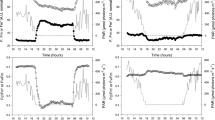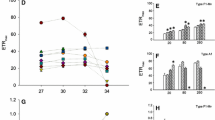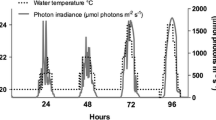Abstract
Damage to zooxanthellae photosynthetic apparatus has been proposed to be the underlying mechanism of coral bleaching, but how the expulsion of zooxanthellae is triggered is still not understood. The present study compared the photosystem II (PSII) functioning and overall photosynthesis of retained and released zooxanthellae from the reef-building coral Galaxea fascicularis exposed to high temperature stress. The use of pulse-amplitude-modulated (PAM) fluorometry for isolated zooxanthellae was validated and used to measure photosynthesis. There was no significant difference in PSII functioning and the overall photosynthesis between retained zooxanthellae, which were isolated immediately after stress treatment, and those released from the coral exposed to either 30 or 32°C, while the zooxanthellae population released at 28°C showed significantly lower PSII functioning than those retained in the polyps. The release of healthy-looking zooxanthellae by polyps exposed to elevated temperatures was significantly higher than those in the control (28°C). Higher release of undischarged cnidae, indicative of host cell necrosis or detachment, was observed in 32°C treatments. These findings indicate that the zooxanthellae released in 30 or 32°C treatments exhibited normal morphology and intact photosynthetic activity. The present results strongly suggest that the release of zooxanthellae from G. fascicularis at 30 or 32°C is a non-selective process with respect to the zooxanthellar PSII functioning and thus the host seems to be the first partner to be physiologically affected in temperature-induced bleaching.




Similar content being viewed by others
References
Bhagooli R (2001) Coral bleaching: mechanisms and stress susceptibility. MSc thesis, University of the Ryukyus, Okinawa, Japan
Bhagooli R, Hidaka M (2002) Physiological responses of the coral Galaxea fascicularis and its algal symbiont to elevated temperatures. Galaxea Jpn Coral Reef Soc 4:33–42
Bhagooli R, Hidaka M (2003) Comparison of stress susceptibility of in hospite and isolated zooxanthellae among five coral species. J Exp Mar Biol Ecol 291:181–197
Brown BE (1997) Coral bleaching: causes and consequences. Coral Reefs 16:S129–S138
Brown BE, LeTissier MDA, Bythell JC (1995) Mechanisms of bleaching deduced from histological studies of reef corals sampled during a natural bleaching event. Mar Biol 122:655–663
Brown BE, Downs CA, Dunne RP, Gibb SW (2002) Exploring the basis of thermotolerance in the reef coral Goniastrea aspera. Mar Ecol Prog Ser 242:119–129
Dunn SR, Bythell JC, LeTissier MDA, Burnett WJ, Thomason JC (2002) Programmed cell death and cell necrosis activity during hyperthermic stress-induced bleaching of the symbiotic sea anemone Aiptasia sp. J Exp Mar Biol Ecol 272:29–53
Dunne RP, Brown BE (2001) The influence of solar radiation on bleaching of shallow water reef corals in the Andaman Sea, 1993–1998. Coral Reefs 20:201–210
Fitt WK, Warner ME (1995) Bleaching patterns of four species of Caribbean reef corals. Biol Bull 187:298–307
Fitt WK, Brown BE, Warner ME, Dunne RP (2001) Coral bleaching: interpretation of thermal tolerance limits and thermal thresholds in tropical corals. Coral Reefs 20:51–65
Gates RD, Baghdasarian G, Muscatine L (1992) Temperature stress causes host cell detachment in symbiotic cnidarians: implications for coral bleaching. Biol Bull 182:324–332
Genty B, Briantais JM, Baker NR (1989) The relationship between the quantum yield of photosynthetic electron transport and quenching of chlorophyll fluorescence. Biochem Biophys Acta 990:87–92
Glynn PW (1993) Coral bleaching: ecological perspectives. Coral Reefs 12:1–17
Glynn PW, D’Croz L (1990) Experimental evidence for high temperature stress as the cause of El Niño-coincident coral mortality. Coral Reefs 8:181–191
Glynn PW, Peters EC, Muscatine L (1985) Coral tissue microstructure and necrosis: relation to catastrophic coral mortality in Panama. Dis Aquat Org 1:29–38
Hayes RL, Bush PG (1990) Microscopic observations of recovery in the reef-building scleractinian coral, Montastrea annularis, after bleaching on a Cayman reef. Coral Reefs 8:203–210
Hoegh-Guldberg O (1999) Climate change, coral bleaching and the future of the world’s coral reefs. Mar Freshw Res 50:839–869
Hoegh-Guldberg O (2000) Global climate change and the thermal tolerance of corals. Galaxea Jpn Coral Reef Soc 2:1–11
Iglesias-Prieto R (1997) Temperature-dependent inactivation of photosystem II in symbiotic dinoflagellates. Proc 8th Int Coral Reef Symp 2:1313–1318
Iglesias-Prieto R, Trench RK (1994) Acclimation and adaptation to irradiance in symbiotic dinoflagellates I. Responses of the photosynthetic unit to changes in photon flux density. Mar Ecol Prog Ser 113:163–175
Iglesias-Prieto R, Matta JL, Robins WA, Trench RK (1992) Photosynthetic response to elevated temperature in the symbiotic dinoflagellate Symbiodinium microadriaticum in culture. Proc Natl Acad Sci U S A 89:10302–10305
Johannes RE, Wiebe WJ (1970) A method for determination of coral tissue biomass and composition. Limnol Oceanogr 21:540–547
Jones RJ, Hoegh-Guldberg O, Larkum AWD, Schreiber U (1998) Temperature-induced bleaching of corals begins with impairment of the CO2 fixation mechanism in zooxanthellae. Plant Cell Environ 21:1219–1230
Lesser MP (1996) Exposure of symbiotic dinoflagellates to elevated temperatures and ultraviolet radiation causes oxidative stress and inhibits photosynthesis. Limnol Oceanogr 41:271–283
Lesser MP, Shick JM (1989) Effects of irradiance and ultraviolet radiation on photoadaptation in the zooxanthellae of Aiptasia pallida: primary production, photoinhibition, and enzymatic defenses against oxygen toxicity. Mar Biol 102:243–255
Masuda K, Goto M, Maruyama T, Miyachi S (1993) Adaptation of solitary corals and their zooxanthellae to low light and UV radiation. Mar Biol 117:685–691
Mise T, Hidaka M (2003) Degradation of zooxanthellae in the coral Acropora nasuta during bleaching. Galaxea Jpn Coral Reef Soc 5:32–38
Perez SF, Cook CB, Brooks WR (2001) The role of symbiotic dinoflagellates in the temperature-induced bleaching response of the subtropical sea anemone Aiptasia pallida. J Exp Mar Biol Ecol 256:1–14
Ralph PJ, Gademann R, Larkum AWD (2001) Zooxanthellae expelled from bleached corals at 33°C are photosynthetically competent. Mar Ecol Prog Ser 220:163–168
Sawyer SJ, Muscatine L (2001) Cellular mechanisms underlying temperature-induced bleaching in the tropical sea anemone Aiptasia pulchella. J Exp Biol 204:3443–3456
Shick JM, Lesser MP, Dunlap WC, Stochaj WR, Chalker BE, Won JW (1995) Depth-dependent responses to solar ultraviolet radiation and oxidative stress in the zooxanthellate coral Acropora microphthalma. Mar Biol 122:41–51
Stimson J, Sakai K, Sembali H (2002) Interspecific comparison of the symbiotic relationship in corals with high and low rates of bleaching-induced mortality. Coral Reefs 21:409–421
Suharsono, Pipe RK, Brown BE (1993) Cellular and ultrastructural changes in the endoderm of the temperate sea-anemone Anemonia viridis as a result of increased temperature. Mar Biol 116:311–318
Titlyanov EA, Titlyanova TV, Leletkin VA, Tsukahara J, Woesik R van, Yamazato K (1996) Degradation of zooxanthellae and regulation of their density in hermatypic corals. Mar Ecol Prog Ser 139:167–178
Titlyanov EA, Titlyanova TV, Yamazato K (2001) Formation, growth and photo-acclimation of colonies of the hermatypic coral Galaxea fascicularis under different light conditions. Symbiosis 30:257–274
Warner ME, Fitt WK, Schmidt GW (1996) The effects of elevated temperature on the photosynthetic efficiency of zooxanthellae in hospite from four different species of reef coral: a novel approach. Plant Cell Environ 19:291–299
Warner ME, Fitt WK, Schmidt GW (1999) Damage to photosystem II in symbiotic dinoflagellates: a determinant of coral bleaching. Proc Natl Acad Sci U S A 96:8007–8012
Acknowledgements
The authors would like to thank the staff of Sesoko Station, Tropical Biosphere Research Center, University of the Ryukyus, for allowing us to use the facilities and for providing records of coastal observation at Sesoko Station. This study was partly supported by grants for coral reef research from the Cabinet Office of Japan. RB is thankful to the Ministry of Education, Culture, Sports, Science and Technology, Japan for a scholarship. Coral specimens were collected under permission of the Okinawa prefecture government.
Author information
Authors and Affiliations
Corresponding author
Additional information
Communicated by T. Ikeda, Hakodate
Rights and permissions
About this article
Cite this article
Bhagooli, R., Hidaka, M. Release of zooxanthellae with intact photosynthetic activity by the coral Galaxea fascicularis in response to high temperature stress. Marine Biology 145, 329–337 (2004). https://doi.org/10.1007/s00227-004-1309-7
Received:
Accepted:
Published:
Issue Date:
DOI: https://doi.org/10.1007/s00227-004-1309-7




